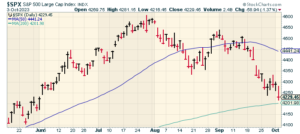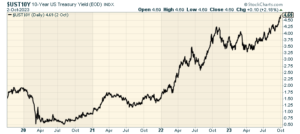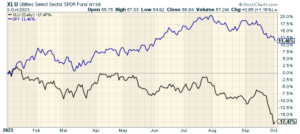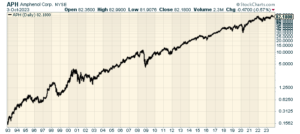CWS Market Review – October 3, 2023
(This is the free version of CWS Market Review. If you like what you see, then please sign up for the premium newsletter for $20 per month or $200 for the whole year. If you sign up today, you can see our two reports, “Your Handy Guide to Stock Orders” and “How Not to Get Screwed on Your Mortgage.”)
The Stock Market Continues to Drift Lower
Wall Street is still in a cranky mood, and the culprit is higher interest rates. There appears to be an emerging consensus that the Federal Reserve will hold interest rates “higher for longer.”
Wall Street doesn’t like that. Last week, the S&P 500 closed out its first losing quarter since Q3 of last year. The index continued to fall today. The S&P 500 closed at its lowest level since June. The Dow is now down for the year.
The S&P 500 has already dropped below its 50-day moving average and it’s not too far from breaking below its 200-day moving average. The index has traded above its 200-DMA without stopping for six straight months. Falling below moving averages is often an omen of bad things to come.
What’s next? All eyes are focused on Friday’s jobs report. So far, the labor market has remained calm, but any weakness could convince the bears that they’ve been right.
For August, the economy created 187,000 net new jobs. That was higher than both June and July, and the unemployment rate rose from 3.5% to 3.8%. For this Friday, Wall Street expects to see 170,000 net new jobs created for September and it expects the unemployment rate to fall to 3.7%.
However, the number I’ll be watching most closely is average hourly earnings. The consensus on Wall Street is for earnings to rise by 0.3%. Workers have been getting paid more but that’s mostly keeping with inflation. That’s probably part of the reason why we’ve seen organized labor activity recently.
I won’t make a prediction for Friday’s report, but I will note that other labor reports have been pretty good. For example, the initial jobless claims report is near a seven-month low. On Tuesday, the Bureau of Labor Statistics said that job openings increased in August from 8.9 million to 9.6 million.
I was also impressed by Monday’s ISM Manufacturing Index. This report comes out on the first business day of the month. Monday’s report came in at 49.0. Any number above 50 means the factory sector of the economy is growing, and any number below 50 means it’s contracting.
This was the 11th month in a row of contraction, but it wasn’t by much. Monday’s report was the highest in 10 months.
Despite those selected positive notes, Wall Street seems to be very worried.
As grumpy as the stock market has been, the bond market is even grumpier. On Tuesday, the yield on the 10-year Treasury reached its highest level since 2007.
The yield on the 10-year got as high as 4.781% while the 30-year reached 4.874%, also the highest since 2007. A little over three years ago, the 10-year yield was going for just 0.5%.
Rising interest rates are bad for stocks for two major reasons. One is that interest expense is an important part of a company’s income statement. If it costs more to borrow money, companies will do less of it. It also costs more to refinance existing debt.
The other reason is that higher yields provide stronger competition for investors’ money. The one-year Treasury is going for 5.5%. Sure, it’s not for me, but I certainly can understand investors who’d prefer to make an easy 5.5% for one year than deal with the frenzy of stock market volatility. That 5.5% works out to more than 1,800 Dow points over the coming year, and it’s basically risk-free. What we want to look at isn’t so much the absolute level of interest rates but rather, their direction. Lower yields are good for stocks and higher yields are dangerous.
What’s interesting is that “real” yields, meaning after inflation, are rising as well. Since May 11, the yield on the 10-year TIPs, the inflation-adjusted security, has increased by 1%. It’s not just an inflation story (but that is a big problem).
The two-year yield is often considered to be the maturity that is most sensitive to the Fed’s interest-rate policy. The two-year yield recently rose to 5.129%.
The Federal Reserve doesn’t meet for another month, but the interest rate “hawks” have gotten a little stronger. The futures market still indicates that the Fed will pause at its next meeting, but the dissenters are growing. One week ago, the odds of a 0.25% rate hike in November were just 16%. Now they’re at 30%.
This week, Raphael Bostic, head of the Atlanta Fed, said he can see interest rates at the current range of 5.25% to 5.5% well into next year.
He’s not alone. Loretta Mester, the president of the Cleveland Fed, said rates could be held higher “for some time.” The next CPI report will be out on Thursday, October 12.
I’ve also been struck by how many conservative stocks have been getting squeezed by this market. For example, utility stocks are lagging badly. Check out this chart of the S&P 500 versus the S&P 500 Utility ETF:
Related to this is that growth stocks have been holding up much better than value stocks have this year. I’m not sure that can last for much longer. If the broader economy starts to get shaky, that will help the relative performance of many defensive stocks.
The Boring Stock Portfolio
In his book, One Up on Wall Street, Peter Lynch extolled the virtues of investing in boring stocks. There are many stocks that are very good businesses, but they really don’t do anything interesting. As such, investors tend to overlook them.
Just because the sector isn’t interesting doesn’t mean it’s not important, or unprofitable. These are companies that are rarely mentioned on TV.
There’s a group of boring stocks that I like to follow. Here’s a sample of some good but very dull stocks.
American Water Works (AWK) is a nice, dull stock. AWK is a public utility that provides water to 1,700 communities across 24 states. Water is a good business to be in. No town wants to be another Flint, Michigan water disaster.
American Water “owns 80 surface water treatment plants, 480 groundwater treatment plants, 160 wastewater treatment plants, 52,500 miles of pipes, 1,100 groundwater wells, 1,700 pumping stations, 1,300 water storage facilities, and 76 dams.”
Amphenol (APH) is a former Buy List stock. The company makes electronic and fiber optic connectors. Bor-ing. Over the last 31 years, it’s up more than 42,000%.
Many people assume that Clorox (CLX) is a brand that’s owned by some larger multinational. No so. Clorox owns Clorox. The company also owns Pine-Sol and Liquid-Plumr. Clorox was founded in 1913.
Cummins (CMI) is an engine company but it’s so much more. The company makes diesel and natural gas engines, plus electric and hybrid powertrains. It’s also engaged in filtration and power generation. Cummins employs more than 70,000 people around the world.
Donaldson (DCI) is a filtration company. It makes air filters for several different sectors. Another former Buy List stock.
Eaton (ETN) is a power management company that’s based in Dublin, Ireland. The company has been listed on the NYSE for 100 years. Only 32 companies have been listed that long.
Graco (GGG) makes fluid-handling systems. Snore. Over the last 30 years, it’s only up 20,000%.
Illinois Tool Works (ITW) “produces engineered fasteners and components, equipment and consumable systems, and specialty products.” Yes, it’s based in Illinois.
Public Storage (PSA) is the largest self-storage real estate investment trust (REIT) in the United States. There are currently more than 2,600 Public Storage locations around the world. PSA has relatively few employees. The lots are automated so customers can access their units at any time.
The company does a lot more than just provide the space. They also provide a broad range of services for their clients. PSA offers insurance and packing products. The company also had a subsidiary that provides boxes and truck rentals.
Sysco (SYY) is a major supplier to restaurants and dining facilities. The company has 600,000 clients.
WD-40 (WDFC) is like Clorox. Many people assume it’s a brand owned by a larger company. Nope, WD-40 is owned by WD-40.
Most every homeowner is familiar with WD-40. The lubricant spray is instantly recognizable by its yellow and blue label. Some folks at the firm were working on a Water Displacement formula. The first 39 tries failed, but #40 worked and the name was born.
Did you know WD-40 can soften leather? It can also clean tile and erase crayon. It can even unstick Legos.
That’s all for now. I’ll have more for you in the next issue of CWS Market Review.
– Eddy
P.S. If you want more info on our ETF, you can check out the ETF’s website.
Posted by Eddy Elfenbein on October 3rd, 2023 at 7:41 pm
The information in this blog post represents my own opinions and does not contain a recommendation for any particular security or investment. I or my affiliates may hold positions or other interests in securities mentioned in the Blog, please see my Disclaimer page for my full disclaimer.
-
-
Archives
- April 2025
- March 2025
- February 2025
- January 2025
- December 2024
- November 2024
- October 2024
- September 2024
- August 2024
- July 2024
- June 2024
- May 2024
- April 2024
- March 2024
- February 2024
- January 2024
- December 2023
- November 2023
- October 2023
- September 2023
- August 2023
- July 2023
- June 2023
- May 2023
- April 2023
- March 2023
- February 2023
- January 2023
- December 2022
- November 2022
- October 2022
- September 2022
- August 2022
- July 2022
- June 2022
- May 2022
- April 2022
- March 2022
- February 2022
- January 2022
- December 2021
- November 2021
- October 2021
- September 2021
- August 2021
- July 2021
- June 2021
- May 2021
- April 2021
- March 2021
- February 2021
- January 2021
- December 2020
- November 2020
- October 2020
- September 2020
- August 2020
- July 2020
- June 2020
- May 2020
- April 2020
- March 2020
- February 2020
- January 2020
- December 2019
- November 2019
- October 2019
- September 2019
- August 2019
- July 2019
- June 2019
- May 2019
- April 2019
- March 2019
- February 2019
- January 2019
- December 2018
- November 2018
- October 2018
- September 2018
- August 2018
- July 2018
- June 2018
- May 2018
- April 2018
- March 2018
- February 2018
- January 2018
- December 2017
- November 2017
- October 2017
- September 2017
- August 2017
- July 2017
- June 2017
- May 2017
- April 2017
- March 2017
- February 2017
- January 2017
- December 2016
- November 2016
- October 2016
- September 2016
- August 2016
- July 2016
- June 2016
- May 2016
- April 2016
- March 2016
- February 2016
- January 2016
- December 2015
- November 2015
- October 2015
- September 2015
- August 2015
- July 2015
- June 2015
- May 2015
- April 2015
- March 2015
- February 2015
- January 2015
- December 2014
- November 2014
- October 2014
- September 2014
- August 2014
- July 2014
- June 2014
- May 2014
- April 2014
- March 2014
- February 2014
- January 2014
- December 2013
- November 2013
- October 2013
- September 2013
- August 2013
- July 2013
- June 2013
- May 2013
- April 2013
- March 2013
- February 2013
- January 2013
- December 2012
- November 2012
- October 2012
- September 2012
- August 2012
- July 2012
- June 2012
- May 2012
- April 2012
- March 2012
- February 2012
- January 2012
- December 2011
- November 2011
- October 2011
- September 2011
- August 2011
- July 2011
- June 2011
- May 2011
- April 2011
- March 2011
- February 2011
- January 2011
- December 2010
- November 2010
- October 2010
- September 2010
- August 2010
- July 2010
- June 2010
- May 2010
- April 2010
- March 2010
- February 2010
- January 2010
- December 2009
- November 2009
- October 2009
- September 2009
- August 2009
- July 2009
- June 2009
- May 2009
- April 2009
- March 2009
- February 2009
- January 2009
- December 2008
- November 2008
- October 2008
- September 2008
- August 2008
- July 2008
- June 2008
- May 2008
- April 2008
- March 2008
- February 2008
- January 2008
- December 2007
- November 2007
- October 2007
- September 2007
- August 2007
- July 2007
- June 2007
- May 2007
- April 2007
- March 2007
- February 2007
- January 2007
- December 2006
- November 2006
- October 2006
- September 2006
- August 2006
- July 2006
- June 2006
- May 2006
- April 2006
- March 2006
- February 2006
- January 2006
- December 2005
- November 2005
- October 2005
- September 2005
- August 2005
- July 2005




 Eddy Elfenbein is a Washington, DC-based speaker, portfolio manager and editor of the blog Crossing Wall Street. His
Eddy Elfenbein is a Washington, DC-based speaker, portfolio manager and editor of the blog Crossing Wall Street. His